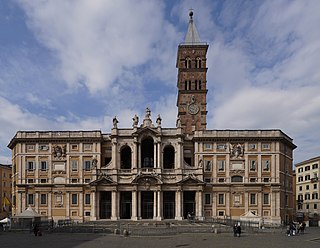
A shrine to the Virgin Mary is a shrine marking an apparition or other miracle ascribed to the Blessed Virgin Mary, or a site on which is centered a historically strong Marian devotion. Such locales are often the destinations of pilgrimages.

Palacio de los Leones is the name of the main municipal building of the city of Rosario, Argentina. The Palace is the seat of the executive branch of the municipal government. It is located at the corner of Buenos Aires and Santa Fe Streets, in front of Plaza 25 de Mayo, and separated from the Cathedral by the promenade known as Pasaje Juramento, which leads to the National Flag Memorial.
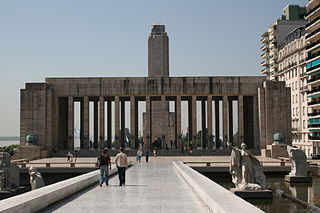
The National Flag Memorial in Rosario, Argentina, is a monumental complex built near the shore of the Paraná River. It was inaugurated on June 20, 1957, the anniversary of the death of Manuel Belgrano, creator of the Argentine flag, who raised it for the first time on an island on the opposite shore of the river on February 27, 1812.
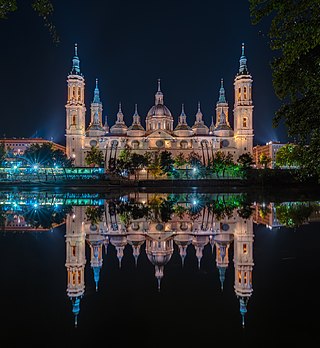
The Cathedral-Basilica of Our Lady of the Pillar is a Roman Catholic church in the city of Zaragoza, Aragon (Spain). The basilica venerates Blessed Virgin Mary, under her title Our Lady of the Pillar praised as "Mother of the Hispanic Peoples" by Pope John Paul II. It is reputed to be the first church dedicated to Mary in history.

The Juan B. Castagnino Fine Arts Museum is an art museum in the city of Rosario, province of Santa Fe, Argentina, considered the most important of the interior of the country and the second in national terms. It is administered by the municipal government. The museum lies within the Parque de la Independencia immediately outside the city center, at the intersection of Oroño Boulevard and Pellegrini Avenue.
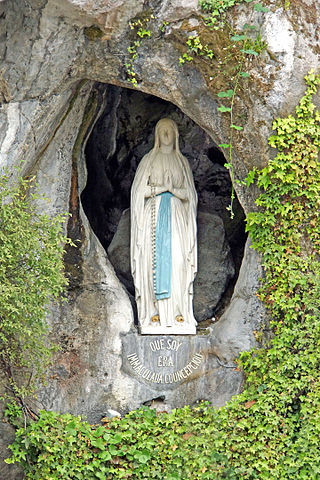
Our Lady of Lourdes is a title of the Virgin Mary. She is venerated under this title by the Roman Catholic church due to her apparitions that occurred in Lourdes, France. The first apparition of 11 February 1858, of which Bernadette Soubirous told her mother that a "Lady" spoke to her in the cave of Massabielle while she was gathering firewood with her sister and a friend. Similar apparitions of the "Lady" were reported on 18 occasions that year, until the climax revelation in which she introduced herself as: "I am the Immaculate Conception". On 18 January 1862, the local Bishop of Tarbes Bertrand-Sévère Laurence endorsed the veneration of the Blessed Virgin Mary in Lourdes.
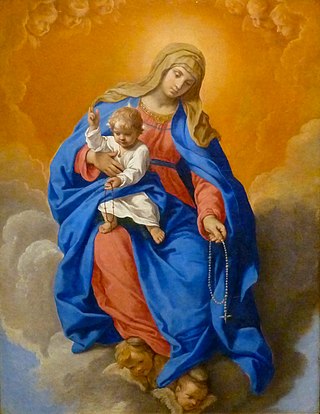
Our Lady of the Rosary, also known as Our Lady of the Holy Rosary, is a Marian title.

The Roman Catholic Archdiocese of Rosario is an ecclesiastical territory or diocese of the Roman Catholic Church in the southern part of the province of Santa Fe, Argentina, with its mother church, the Basilica Cathedral of Our Lady of the Rosary, located in the city of Rosario. The Archbishop since 22 December 2005 is José Luis Mollaghan and the Auxiliary Bishop was Sergio Fenoy, until he was appointed Bishop of San Miguel the 5 December 2006. The former archbishop Eduardo Mirás served as Apostolic Administrator of the Archdiocese between 22 December 2005 and 18 March 2006, the date that Msgr. Mollaghan was installed.

Firma y Odilo Estévez Municipal Decorative Art Museum is the former home of the Estévez family in Rosario, Argentina, which was donated to the Municipality of Rosario and turned into a museum.
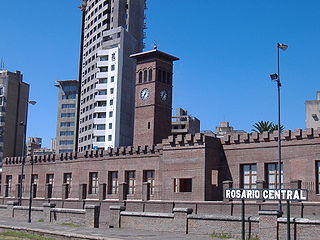
Rosario Central is a former railway station in Rosario, Argentina. It is located at the junction of Corrientes St. and Wheelwright Avenue, in the city center, not far from the coast of the Paraná River.

Plaza 25 de Mayo is a plaza in Rosario, province of Santa Fe, Argentina. It is Rosario's civic center, and the core of the original settlement. Its name alludes to the date of the May Revolution, which led to the establishment of the first local Argentine government in Buenos Aires. Before 1852, when this name was adopted, it was simply called Plaza Principal.

La Bola de Nieve is a historical building in the city of Rosario, Santa Fe Province, Argentina. Its name alludes to the presence of a large stone sphere on its top.
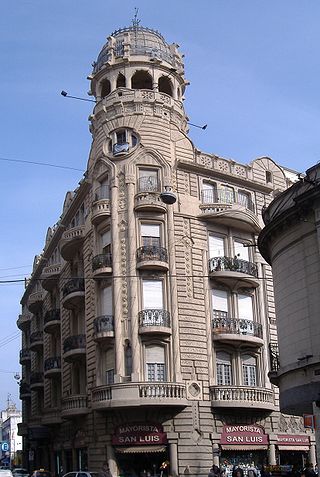
The Palacio Cabanellas is a historical building in the city of Rosario, province of Santa Fe, Argentina. It is located in the downtown area, occupying the southwestern corner of San Luis St. and Sarmiento St.

Our Lady, Queen of the Most Holy Rosary Cathedral is a Roman Catholic church located at 2535 Collingwood Boulevard in the Old West End of Toledo, Ohio. The cathedral is the mother church of the 122 parishes in the Roman Catholic Diocese of Toledo. This cathedral is unique architecturally in that it was designed in the Spanish Plateresque style. It was designed with Toledo's Sister City, Toledo, Spain in mind. Finished in 1931, it was built in the spirit of the great European cathedrals of the Middle Ages.

Catholic Marian churches are religious buildings dedicated to the veneration of the Blessed Virgin Mary. These churches were built throughout the history of the Catholic Church, and today they can be found on every continent including Antarctica. The history of Marian church architecture tells the unfolding story of the development of Catholic Mariology.
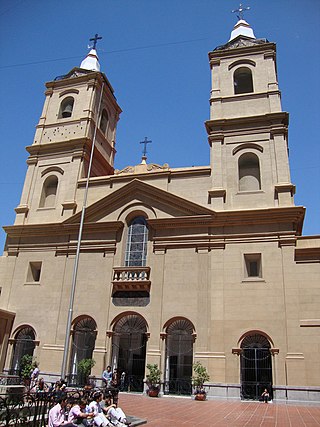
The Santo Domingo Convent, or Basilic of Our Lady of the Rosary and Convent of Santo Domingo is a convent for Our Lady of the Rosary located in the Monserrat neighborhood of Buenos Aires. Built during the colonial times, it was the scenario of a military conflict during the British invasions of the Río de la Plata. It holds as well the tomb of the Argentine national hero Manuel Belgrano.

The Cathedral Basilica of Our Lady of the Rosary, also known as Culiacán Cathedral, is the Catholic cathedral that serves as the headquarters of the diocese of Culiacán, Mexico, although it is not the oldest temple in the municipality, since it dates from 1842. The oldest are the Tabalá and Tacuichamona temples.

Our Lady of the Rosary of San Nicolás is, in Catholicism, a title of veneration of the Virgin Mary associated with a reported private revelation to Gladys Quiroga de Motta, a middle-aged housewife, beginning in the 1980s in the city of San Nicolás de los Arroyos, Argentina. Quiroga said that she was tasked with promoting devotion to the Mother of God under this title, with an emphasis on key passages in the Bible and a particular mystical stellar symbolism. The apparitions continue almost every day since 1983 and have been approved the catholic Church. Messages from 1983 to 1990 virgen san nicolas/consulta de mensajes.htm|Mensajes María del Rosario de SN 1983-1990 Español have been officially published and miracles, conversions and healings occur in the Sanctuary. María Del Rosario de San Nicolas is calling Catholics to pray one hour per day, daily eucharistic and conversion. She is the ark of the Covenant that leads us to back to God, by the Mercy and love of Christ to prepare us for His second coming that will also be based in love.


















